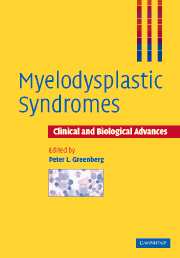Book contents
- Frontmatter
- Contents
- List of contributors
- Preface
- 1 Clinical and prognostic characterization of myelodysplastic syndromes
- 2 Morphologic classifications of myelodysplastic syndromes: French–American–British (FAB) and World Health Organization (WHO)
- 3 Pathogenetic mechanisms underlying myelodysplastic syndromes
- 4 Cytogenetic abnormalities in myelodysplastic syndromes
- 5 Molecular mechanisms and gene expression patterns in myelodysplastic syndromes
- 6 Immunologic mechanisms and treatment of myelodysplastic syndromes
- 7 Biologically targeted therapies for myelodysplastic syndromes
- 8 Supportive care in myelodysplastic syndromes: hemopoietic cytokine and iron chelation therapy
- 9 Hematopoietic cell transplantation for myelodysplastic syndromes
- 10 Health-related quality of life for those with myelodysplastic syndrome: conceptualization, measurement, and implications for research and practice
- Index
- Plate section
- References
10 - Health-related quality of life for those with myelodysplastic syndrome: conceptualization, measurement, and implications for research and practice
Published online by Cambridge University Press: 22 August 2009
- Frontmatter
- Contents
- List of contributors
- Preface
- 1 Clinical and prognostic characterization of myelodysplastic syndromes
- 2 Morphologic classifications of myelodysplastic syndromes: French–American–British (FAB) and World Health Organization (WHO)
- 3 Pathogenetic mechanisms underlying myelodysplastic syndromes
- 4 Cytogenetic abnormalities in myelodysplastic syndromes
- 5 Molecular mechanisms and gene expression patterns in myelodysplastic syndromes
- 6 Immunologic mechanisms and treatment of myelodysplastic syndromes
- 7 Biologically targeted therapies for myelodysplastic syndromes
- 8 Supportive care in myelodysplastic syndromes: hemopoietic cytokine and iron chelation therapy
- 9 Hematopoietic cell transplantation for myelodysplastic syndromes
- 10 Health-related quality of life for those with myelodysplastic syndrome: conceptualization, measurement, and implications for research and practice
- Index
- Plate section
- References
- Type
- Chapter
- Information
- Myelodysplastic SyndromesClinical and Biological Advances, pp. 263 - 296Publisher: Cambridge University PressPrint publication year: 2005
References
- 1
- Cited by



